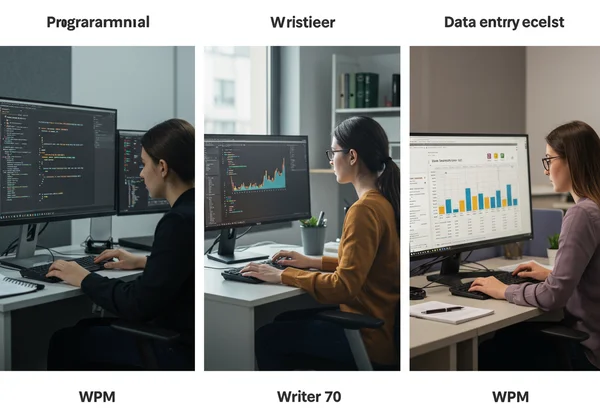Boost Your Career: Typing Speed Benchmarks & Pro Strategies
Feeling like your keyboard is holding you back? Whether you're a programmer, writer, or data entry pro, swift and precise typing isn't just a skill—it's your gateway to next-level productivity. This guide will show you exactly how to master your typing speed, revealing industry benchmarks and practical strategies to elevate your career. Ready to transform your professional output? Measure your WPM today.

Understanding Professional WPM Benchmarks
Knowing where you stand is the first step towards improvement. Professional roles often have unspoken, yet crucial, typing speed expectations. Let’s delve into what’s considered a good WPM score across various high-demand careers. Meeting or exceeding these benchmarks can significantly boost your efficiency and career prospects.
What is a Good WPM for Programmers?
For programmers, typing isn't just about raw speed; it's about accuracy, context switching, and efficiently inputting code, symbols, and commands. While average general typing speeds hover around 40 WPM, a proficient programmer often aims for 60-80 WPM. This range allows for fluid coding, quick debugging, and seamless navigation through development environments without losing their train of thought. A higher typing speed for programmers reduces the friction between thought and execution, making development cycles smoother and faster.
Essential WPM for Writers & Content Creators
Writers and content creators thrive on the rapid translation of ideas into text. For them, a WPM for writers benchmark typically falls between 70-100 WPM. This speed enables them to capture creative flow, draft articles, reports, and marketing copy efficiently, and avoid the frustration of slow input interrupting their thought process. Accuracy is paramount here, as errors can disrupt readability and require extensive editing. The goal is to type as fast as you think, maintaining a seamless flow of words.
Data Entry Typing Speed: Meeting Industry Standards
In roles like data entry, administrative assistance, and customer service, typing speed is often a primary key performance indicator. Professionals in these fields are frequently expected to achieve speeds of 60-90 WPM or higher, with minimal errors. The sheer volume of input makes data entry typing speed a direct measure of productivity. Companies often set specific WPM and accuracy targets for these positions, as even small improvements can lead to significant time and cost savings.
How Increased Speed Impacts Your Daily Productivity
Beyond specific benchmarks, improving your typing speed has a profound impact on overall daily productivity. Imagine saving 10-15 minutes every hour on text-based tasks. Over an 8-hour workday, that's over an hour saved, which can be redirected to higher-value activities. Whether it's crafting emails, writing reports, or communicating with colleagues, enhanced typing skills directly translate into a more efficient and less stressful work experience. This ability to improve work productivity isn't just a number; it's a competitive advantage.

Actionable Strategies to Elevate Your Professional Typing Skills
Now that you understand the benchmarks, let's explore practical strategies to help you reach and exceed them. Developing professional typing skills requires focused effort and the right tools.
Tailored Drills for Code Accuracy & Speed
Programmers benefit immensely from practicing with code snippets. Instead of generic text, focus on drills that include common programming keywords, symbols (< > { } [ ] ;), and variable names. Many online tools, including our platform, allow you to use custom text. You'll find this feature invaluable for targeted practice, helping you build muscle memory for the specific characters and structures encountered in coding. Regular practice with relevant material will refine your typing speed for programmers in a way generic tests cannot.
Enhancing Flow for Writers: Focus on Rhythm & Accuracy
For writers, maintaining a smooth flow is crucial. Practice typing full sentences and paragraphs rather than individual words. Concentrate on developing a consistent rhythm & accuracy, ensuring each word is typed correctly the first time. Focus on touch typing – typing without looking at the keyboard – as this builds strong muscle memory and allows you to keep your eyes on the screen, your thoughts, or your source material. Try typing prose from your favorite books or articles to make practice engaging.
Optimizing Efficiency in Data Entry: Batch Processing & Shortcuts
Data entry efficiency isn't just about fast typing; it's about smart typing. Learn and utilize keyboard shortcuts for common actions in your software (e.g., copy, paste, save, navigate fields). Consider batch processing & shortcuts for repetitive tasks. Practice typing numerical data, dates, and common data fields. The goal is to minimize mouse usage and maximize keyboard-driven workflow. Consistent, focused drills on these specific data types will yield significant improvements.
Leveraging Our Platform for Targeted Practice & Progress
Our platform offers a free and intuitive WPM test to measure and improve your typing skills. After understanding your current WPM, you can use our customizable test features to target specific areas of improvement. Want to practice programming syntax? Paste your code. Need to refine your essay writing speed? Use a paragraph from your draft. The real-time feedback and detailed results report after each test give you clear insights into your WPM, CPM, and accuracy, helping you track your progress. Try our free tool today to apply these strategies and see your skills grow.

Beyond the Keyboard: Cultivating Sustainable Typing Habits
Improving your typing speed is a marathon, not a sprint. Sustainable progress involves not just practice, but also adopting habits that promote long-term efficiency and prevent strain.
The Importance of Accuracy Over Raw Speed
While speed is impressive, accuracy is paramount. A high WPM with a low accuracy rate means more time spent on corrections, ultimately negating any speed advantage. Always prioritize typing correctly. Focus on precision first, and speed will naturally follow as your fingers develop muscle memory for correct keystrokes. This commitment to accuracy over raw speed is a hallmark of truly professional typists. Mistakes cost time, and in a professional setting, they can also cost credibility.
Ergonomics & Breaks for Peak Performance
Long hours at the keyboard can lead to discomfort or even injury. Ensure your workstation is ergonomically set up:
-
Chair: Provides good lumbar support, allowing your feet to be flat on the floor.
-
Keyboard & Mouse: Positioned close to your body, with wrists straight.
-
Monitor: At eye level, about an arm's length away. Regular short breaks (5-10 minutes every hour) are also crucial. Use this time to stretch your hands, wrists, and shoulders. These practices contribute to sustainable peak performance and help prevent issues like carpal tunnel syndrome, ensuring you can type efficiently for years to come.

Unlock Your Full Potential: Start Your Typing Journey Today
Consider improving your typing speed a direct investment in your career. By understanding benchmarks, applying tailored practice, and building healthy habits, you'll significantly boost your productivity and career prospects. Don't let slow typing be the bottleneck holding you back.
Ready to take the next step and transform your typing skills? Visit our typing test tool now. Take your free WPM test, explore customizable practice options, and start your path to becoming a faster, more accurate typist. Test your typing efficiency now!
Frequently Asked Questions About Professional Typing Speed
What is considered a good WPM for general professional use?
For general professional use, a WPM of 50-70 is often considered good. This allows for efficient communication and document creation without significant delays. For roles requiring heavy typing, such as data entry or transcription, 70+ WPM with high accuracy is generally expected.
How can I effectively improve my typing speed for work?
To effectively improve your typing speed for work, focus on touch typing, practice regularly with relevant professional texts (e.g., code, reports, emails), prioritize accuracy over raw speed, and utilize online tools like our platform for targeted practice and progress tracking. Consistent, deliberate practice is key to enhancing your typing speed for work.
Is it true that accuracy is more important than speed?
Yes, absolutely. While speed is a factor, accuracy is more important. Errors require time-consuming corrections, which negates any advantage gained from typing quickly. High accuracy ensures that your work is clean, professional, and doesn't need constant revision, making it more efficient in the long run.
How can this professional typing test help me improve my professional typing?
This platform offers a free online WPM test that provides instant feedback on your speed and accuracy. Its key advantage is the ability to use custom text, allowing you to practice with content directly relevant to your profession (e.g., programming languages, specific industry terminology). This targeted practice helps you develop professional typing skills efficiently, and you can easily track your progress with each test. Start your professional typing journey and see the difference.